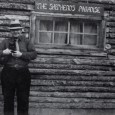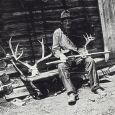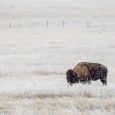The Gift of South Dakota
Subscriptions to South Dakota Magazine make great gifts!
Subscribe today — 1 year (6 issues) is just $29!
South Dakota's Killer Wolf
A gray wolf shot near Custer earlier this year caused a lot of conversation in the southern Black Hills. John Kanta of the Rapid City Game Fish and Parks Department said it wandered from the Great Lakes region. "We have an occasional wolf that wanders through South Dakota. But we don't have a breeding pair. Because of all the livestock we have I don't think they'd fit well here in South Dakota," Kanta told us.
Gray wolves are bigger and stronger than timber wolves. Grays were lording over the river breaks of western South Dakota when farmers and ranchers first settled there. The wolves preyed on livestock, so they were eventually hunted to extinction in South Dakota.
One of the last was a wolf named Three Toes that achieved great notoriety in the hills and plains of northwest South Dakota. Archie Gilfillan, a sheepherder and writer, was intrigued by the local ranchers’ mixture of respect and hate for the wild and wily creature. In his book Sheep, Gilfillan noted that Three Toes "for 13 years laughed at poison, traps and guns, lived in and off enemy country with the hand of every man against him, a cunning, bloodthirsty killer, a super wolf among wolves and the most destructive single animal of which there is any record anywhere.”
So named because he had lost a paw in a trap early in his life, Three Toes gained a reputation as a bloodthirsty killer by 1912. He left his unmistakable paw print at ranches throughout Harding County. Infuriated ranchers tracked his whereabouts and devastating destruction. They estimated that his lifetime of kills exceeded $50,000 in cattle and sheep.
Three Toes lived to an old age, and reached the peak of his destruction in the 1920s. Gilfillan wrote, "For first, last, and all the time, Three Toes was a killer. Other wolves might kill one cow or sheep and eat off that and be satisfied. But Three Toes killed for the sheer love of killing. He would kill on a full stomach as well as when hungry. On one occasion he visited three different ranches in one night, killed many sheep and lambs at each one, but ate only the liver of one lamb."
Officials bumped the bounty for Three Toes to $500, but no hunter could catch the cunning old wolf. In July of 1925, federal wolf hunter Clyde F. Briggs settled on a ranch near the center of Three Toes’ hunting range. For weeks Briggs set his traps and Three Toes carefully eluded them. But he was tricked on July 23 by a hidden trap. The earth around him was scratched and plowed by his frantic efforts to escape from the trap's grasp by the time Briggs arrived. The trapper muzzled and hog-tied the big wolf and put him in the backseat of his car, intending to deliver him to Rapid City alive. But soon a passenger cried, "I think he's dying."
"Briggs stopped the car, and looking around, found the wolf's eyes fixed on him. But the eyes did not see him, for the wolf was dead," wrote Gilfillan. "Call it a broken heart, or what you will — something of this sort is what killed the old wolf. He was resting easily when found, his wounds were superficial ... but there was something in his grand old spirit that could not brook capture, and Nature, more merciful than he had ever been, granted him his release."











Comments
The story of "old Dakota Three Toes" should not be a clarion call for the elimination of a species. This wolf and a few others who were the last of their kind were often disabled from trap injuries, gunshot wounds, poison and/or old age and do not fit the typical pattern of behavior of intelligent pack animals. They were the way they were due to adapting to their circumstances in order to survive.
I plant hardwood trees to help bring a little environmental balance to the world and value what trees do for our environment. I also have a large deer herd which likes to browse my young trees to death. Many times I wished that large predators like wolves, existed to help control this damage but alas, they wouldn't be able to survive in northern Indiana now as they would be shot so that the deer hunters would have enough "easy" targets. So, now the deer have die offs from starvation in winter and disease issues are now cropping up due to their expansive numbers. The predators would have helped prevent these calamities from occurring.
I hope that the wolf and other large predators are not wiped out and will always have a place in the wilderness and our imaginations.